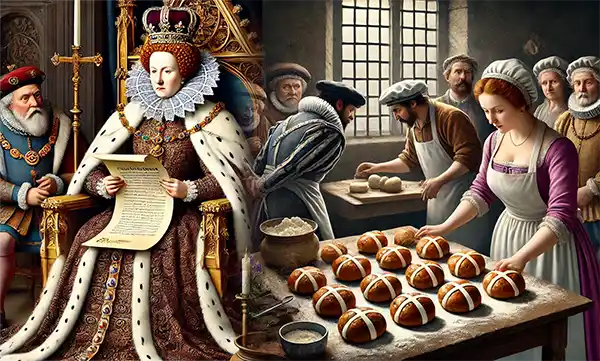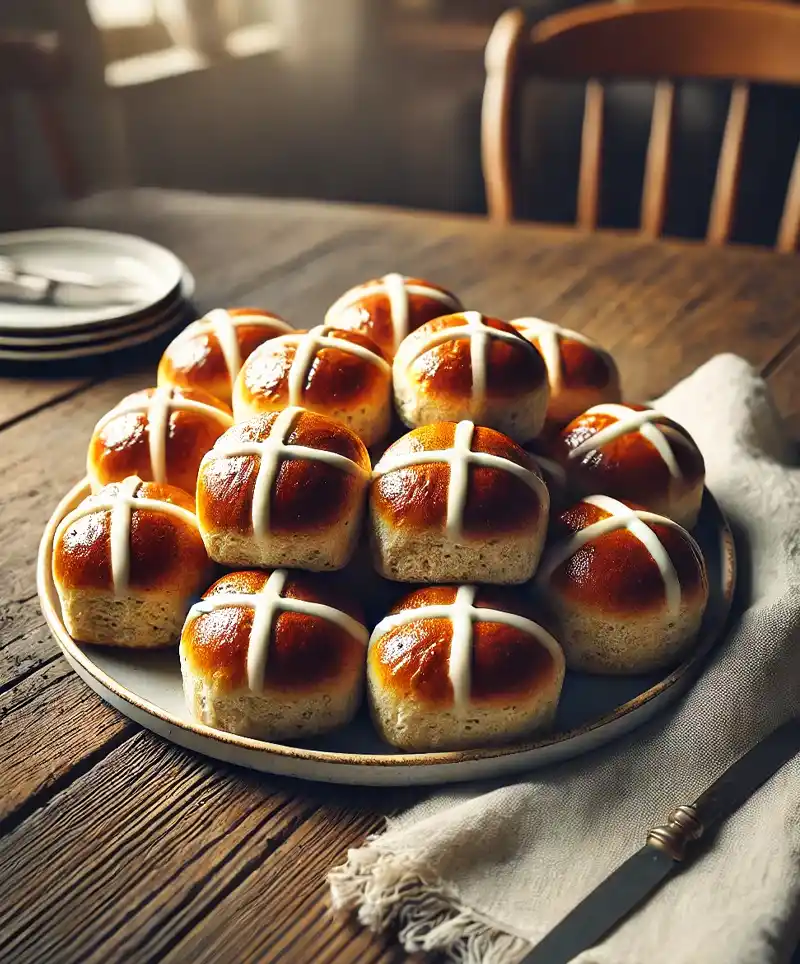The Sweet and Spiced Journey of a Beloved Bun
Every September 11th, while some people are still easing into fall and pumpkin-spiced everything, there’s another treat that demands attention: Hot Cross Buns. This humble yet historical pastry is celebrated on National Hot Cross Bun Day, a day to enjoy these sweet, spiced, and symbolically adorned delights.
The History of Hot Cross Buns
Before they became synonymous with nursery rhymes and cozy breakfasts, Hot Cross Buns had a much deeper connection to religion and tradition. Their roots stretch all the way back to ancient cultures when marking bread with symbols was a way to invoke blessings. Some even suggest that Hot Cross Buns date back to the Saxons, who would bake small, round buns marked with a cross to honor the goddess Eostre (yes, the same goddess who gave us the word Easter). The cross wasn’t just a simple decoration; it represented the four quarters of the moon—a handy celestial nod for people who didn’t have Google Calendar to remind them when the full moon was due.
 Of course, Christianity soon got in on the action. By the 12th century, monks in England were baking Hot Cross Buns for Good Friday to commemorate the crucifixion of Jesus Christ. The buns were enriched with spices to symbolize the embalming process, and the cross on top was a literal representation of the Christian cross. Some even believed the buns had magical powers. (Yes, magical powers. Can your store-bought muffins do that?) These buns were thought to protect homes from fire and bad luck if hung in the kitchen, and sharing one with a friend was believed to cement that friendship for life. So, next time you break bread—or in this case, buns—with someone, just know you might be stuck with them forever.
Of course, Christianity soon got in on the action. By the 12th century, monks in England were baking Hot Cross Buns for Good Friday to commemorate the crucifixion of Jesus Christ. The buns were enriched with spices to symbolize the embalming process, and the cross on top was a literal representation of the Christian cross. Some even believed the buns had magical powers. (Yes, magical powers. Can your store-bought muffins do that?) These buns were thought to protect homes from fire and bad luck if hung in the kitchen, and sharing one with a friend was believed to cement that friendship for life. So, next time you break bread—or in this case, buns—with someone, just know you might be stuck with them forever.
The Rise (and Fall and Rise) of Hot Cross Buns
Fast forward a few hundred years, and Hot Cross Buns had become such a staple of British Good Friday that Queen Elizabeth I herself had to get involved. In the 16th century, she banned the sale of spiced buns and bread except for funerals, Good Friday, and Christmas. The monarchy wasn’t just being a bunch of killjoys; they were worried that the buns had become too popular and were interfering with more “important” occasions. But, as history shows, you can’t keep a good bun down. The people rebelled by baking Hot Cross Buns in secret, ensuring the pastry would live on.
As Hot Cross Buns spread through Europe and eventually across the Atlantic, they lost some of their mystical allure but none of their flavor. Today, we’re less likely to hang them for good luck and more likely to slather them with butter and devour them with our morning coffee. But even without the magical properties, there’s something undeniably comforting about these little buns that have been gracing our tables for centuries.
But What Exactly is a Hot Cross Bun?
If you’re still wondering what exactly makes a Hot Cross Bun different from a regular roll, it’s all about the flavor and the finishing touch. Traditional Hot Cross Buns are sweet yeast buns spiced with cinnamon, nutmeg, and allspice, with currants or raisins folded into the dough. The cross on top, which is the distinguishing feature, is either piped in with icing after baking or made from a flour paste and baked directly onto the bun. You know you're in the presence of greatness when you take a bite and get that perfect blend of soft, spiced dough and the slightly chewy sweetness of dried fruit.
Now, just like anything with a history as long as Hot Cross Buns, there are plenty of modern variations. Some are studded with chocolate chips instead of dried fruit (because, really, what isn’t improved by chocolate?), while others play with different spice blends, glazes, or even citrus zests. But no matter the variety, the cross remains non-negotiable—it’s like the bun’s crown, and without it, you’ve just got a plain old roll. No one’s celebrating National Plain Roll Day, are they?
Hot Cross Buns and Nursery Rhymes
Let’s take a moment to talk about the cultural significance of Hot Cross Buns in nursery rhymes. If you grew up anywhere near an elementary school, you probably heard—or learned to play—the song “Hot Cross Buns” on a recorder. It’s essentially the Wonderwall of children’s instruments. The simple, repetitive tune about selling Hot Cross Buns for "one a penny, two a penny" became a beloved classic for children everywhere.
But here’s the fun part: the rhyme isn’t just an earworm designed to torment parents. It actually harks back to a time when street vendors sold Hot Cross Buns in markets and on the streets. The rhyme’s lyrics, “One a penny, two a penny,” were a reflection of their pricing. Can you imagine strolling through a bustling 18th-century London market and hearing a vendor belting out those words? Makes today’s supermarket shopping feel a bit underwhelming, doesn’t it?
A Few Cheeky Suggestions
So, how should you celebrate National Hot Cross Bun Day? You could bake a batch yourself, of course. Not only will your home smell like a bakery kissed with spices, but you’ll also feel like you’ve tapped into centuries of tradition. If you’re more of a buyer than a baker, head to your local bakery and grab a box. Bonus points if you share them with a friend and test out that "cementing friendships for life" theory.
For the more creative celebrants, why not try creating your own twist on the classic? Hot Cross Bun French toast? Hot Cross Bun bread pudding? Maybe even a Hot Cross Bun breakfast sandwich, if you’re feeling particularly adventurous. The world is your spiced, doughy oyster.
Or, if you're a true traditionalist, hang one in your kitchen for good luck—just don’t blame us if your house guests think you’ve gone a bit loopy.
On the surface, Hot Cross Buns are a delicious snack with a little bit of spice, some dried fruit, and a cute cross on top. But dig a little deeper, and you’ll discover that they’re steeped in history, religion, and tradition, with a fair share of superstition thrown in for good measure. Whether you bake them to ward off bad luck, eat them because they’re delicious, or simply enjoy their nursery rhyme fame, these buns deserve their day of celebration.
And now, every time you hear that simple recorder tune, you’ll know it’s not just about a penny-pinching pastry—it’s about honoring a centuries-old tradition that’s traveled through time, across borders, and straight onto your plate.
Please Share our Content






 Of course, Christianity soon got in on the action. By the 12th century, monks in England were baking Hot Cross Buns for Good Friday to commemorate the crucifixion of Jesus Christ. The buns were enriched with spices to symbolize the embalming process, and the cross on top was a literal representation of the Christian cross. Some even believed the buns had magical powers. (Yes, magical powers. Can your store-bought muffins do that?) These buns were thought to protect homes from fire and bad luck if hung in the kitchen, and sharing one with a friend was believed to cement that friendship for life. So, next time you break bread—or in this case, buns—with someone, just know you might be stuck with them forever.
Of course, Christianity soon got in on the action. By the 12th century, monks in England were baking Hot Cross Buns for Good Friday to commemorate the crucifixion of Jesus Christ. The buns were enriched with spices to symbolize the embalming process, and the cross on top was a literal representation of the Christian cross. Some even believed the buns had magical powers. (Yes, magical powers. Can your store-bought muffins do that?) These buns were thought to protect homes from fire and bad luck if hung in the kitchen, and sharing one with a friend was believed to cement that friendship for life. So, next time you break bread—or in this case, buns—with someone, just know you might be stuck with them forever.








 "Sláinte!" is a traditional Irish expression used as a toast, equivalent to "Cheers!" in English.
"Sláinte!" is a traditional Irish expression used as a toast, equivalent to "Cheers!" in English.